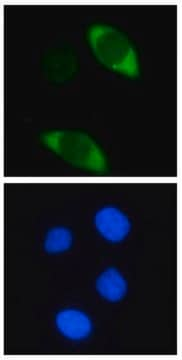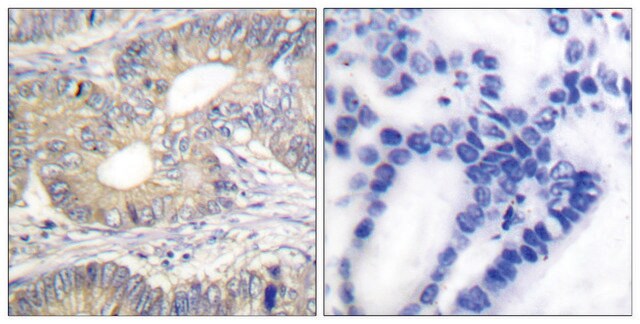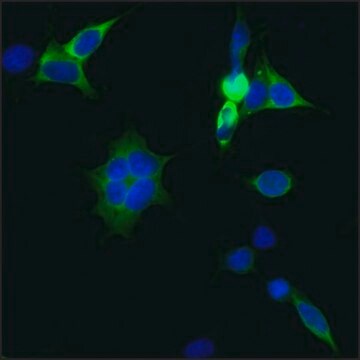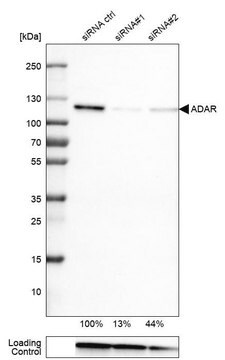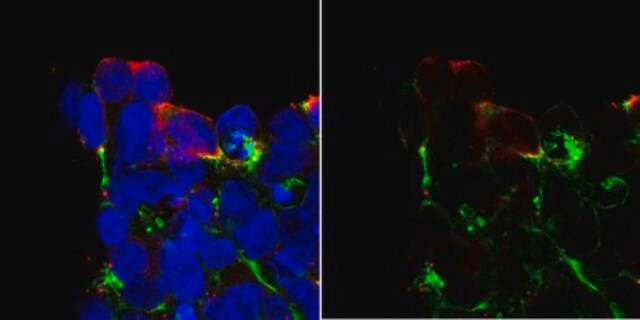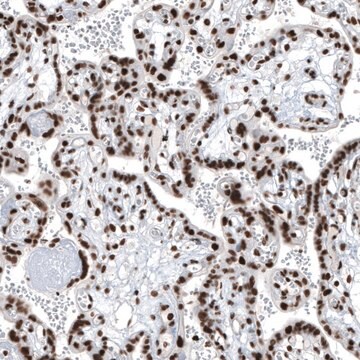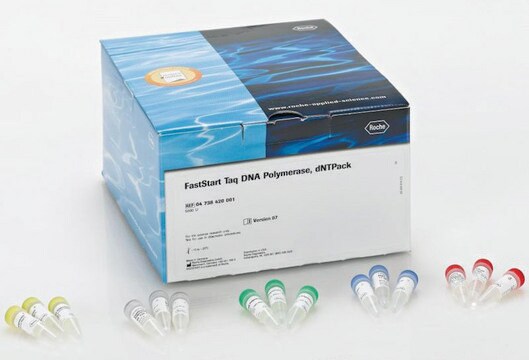추천 제품
생물학적 소스
mouse
Quality Level
항체 형태
purified from hybridoma cell culture
항체 생산 유형
primary antibodies
클론
7A9-3A3, monoclonal
형태
buffered aqueous solution
포장
antibody small pack of 25 μL
농도
~1 mg/mL
기술
immunoblotting: 1-2 μg/mL using whole extracts of human HEK-293T cells over-expressing CAS9 protein
immunofluorescence: 1-2 μg/mL using human HEK-293T cells over-expressing CAS9 protein.
immunoprecipitation (IP): 5-10 μg using whole extract of human HEK-293T cells over-expressing CAS9 protein
동형
IgG1
배송 상태
dry ice
저장 온도
−20°C
타겟 번역 후 변형
unmodified
일반 설명
CAS9, also known as clustered regularly interspaced short palindromic repeats (CRISPR)-associated protein-9 nuclease , cas5 and csn1, is the signature gene of the type II CRISPR -RuvC (RNase H-like fold) cas system. CAS9 contains 1388 amino acids. This protein is predicted to contain a RuvC/ ribonuclease (RNase) H domain involved in crRNA maturation and McrA/HNH signature domain involved in the DNA degradation step.
CRISPR (Clustered Regularly Interspaced Short Palindromic Repeats) belongs to the type II CRISPR/CAS9 system. It is part of an adaptive immune system of the Streptococcus pyogenes SF370, protecting from pathogens targets genes by cleaving the foreign DNA in a sequence-dependent manner.2 The type II CRISPR/Cas system which has been adapted to expression in eukaryotic cells, consists of four genes including the Cas9 (CRISPR-associated proteins) nuclease, two noncoding CRISPR RNAs (crRNAs, or gRNA), trans-activating crRNA (tracrRNA) and a precursor crRNA (pre-crRNA) array. The pre-crRNA contains nuclease guide sequences (spacers) interspaced by identical direct repeats (DRs).
The Cas9 endonuclease can be engineered with a single gRNA, directing a DNA double-strand break (DSB) at a desired genomic location. Similar to DSBs induced by zinc finger nucleases (ZFNs), the cell then activates endogenous DNA repair processes, either non-homologous end joining (NHEJ) or homology-directed repair (HDR), to heal the targeted DSB. In comparison to other genome-editing technologies such as designer zinc fingers (ZFs), transcription activator–like effectors (TALEs) and homing meganucleases, the CRISPR/CAS9 system is a scalable, affordable and easy to engineer. Therefore, the anti-CRISPR/CAS9 antibody can be a useful tool for detecting CRISPR/CAS9 positively transfected cells, reveling DSB sites in the genome and in ChIP (Chromatin Immunoprecipitation) related assays.
The Cas9 endonuclease can be engineered with a single gRNA, directing a DNA double-strand break (DSB) at a desired genomic location. Similar to DSBs induced by zinc finger nucleases (ZFNs), the cell then activates endogenous DNA repair processes, either non-homologous end joining (NHEJ) or homology-directed repair (HDR), to heal the targeted DSB. In comparison to other genome-editing technologies such as designer zinc fingers (ZFs), transcription activator–like effectors (TALEs) and homing meganucleases, the CRISPR/CAS9 system is a scalable, affordable and easy to engineer. Therefore, the anti-CRISPR/CAS9 antibody can be a useful tool for detecting CRISPR/CAS9 positively transfected cells, reveling DSB sites in the genome and in ChIP (Chromatin Immunoprecipitation) related assays.
면역원
a recombinant protein within the N-terminal region of Streptococcus pyogene Cas9
애플리케이션
Monoclonal Anti-CRISPR/CAS9 recognizes over-expression systems containing CAS9 construct. The antibody successfully recognizes mutant Cas9 variants, including nickase Cas9 and dead Cas9 (dCas9). The antibody may be used in various immunochemical techniques including Immunoblotting, Immunofluorescence and Immunoprecipitation. Monoclonal Anti-CRISPR/CAS9 does not cross react with FnCas9 from Francisella novicida bacteria and Cpf1 proteins from Acidaminococcus sp. (strain BV3L6) and Lachnospiraceae bacterium ND2006.
생화학적/생리학적 작용
CAS9 plays a vital role in plasmid DNA interference. It is the only cas protein needed to deliver resistance against foreign DNA. CAS9 stimulates both RNA-guided genome editing and gene regulation in various organisms, but it can facilitate only one activity at a time within any given cell.
물리적 형태
Supplied as a solution in 0.01 M phosphate buffered saline pH 7.4, containing 15 mM sodium azide as a preservative.
저장 및 안정성
For continuous use, store at 2-8°C for up to one month. For extended storage, freeze in working aliquots. Repeated freezing and thawing is not recommended. If slight turbidity occurs upon prolonged storage, clarify the solution by centrifugation before use. Working dilution samples should be discarded if not used within 12 hours.
기타 정보
This product is for R&D use only, not for drug, household, or other uses.
In order to obtain best results in different techniques and preparations we recommend determining optimal working concentration by titration test.
In order to obtain best results in different techniques and preparations we recommend determining optimal working concentration by titration test.
면책조항
Unless otherwise stated in our catalog or other company documentation accompanying the product(s), our products are intended for research use only and are not to be used for any other purpose, which includes but is not limited to, unauthorized commercial uses, in vitro diagnostic uses, ex vivo or in vivo therapeutic uses or any type of consumption or application to humans or animals.
적합한 제품을 찾을 수 없으신가요?
당사의 제품 선택기 도구.을(를) 시도해 보세요.
Storage Class Code
12 - Non Combustible Liquids
WGK
WGK 1
Flash Point (°F)
Not applicable
Flash Point (°C)
Not applicable
시험 성적서(COA)
제품의 로트/배치 번호를 입력하여 시험 성적서(COA)을 검색하십시오. 로트 및 배치 번호는 제품 라벨에 있는 ‘로트’ 또는 ‘배치’라는 용어 뒤에서 찾을 수 있습니다.
이미 열람한 고객
Alicia Davis et al.
Molecular therapy. Methods & clinical development, 25, 158-169 (2022-04-12)
Hypoxia is a characteristic feature of solid tumors that contributes to tumor aggressiveness and is associated with resistance to cancer therapy. The hypoxia inducible factor-1 (HIF-1) transcription factor complex mediates hypoxia-specific gene expression by binding to hypoxia-responsive element (HRE) sequences
L G V Fernandes et al.
Scientific reports, 9(1), 1839-1839 (2019-02-14)
Leptospirosis is a worldwide zoonosis caused by pathogenic bacteria of the genus Leptospira, which also includes free-living saprophyte strains. Many aspects of leptospiral basic biology and virulence mechanisms remain unexplored mainly due to the lack of effective genetic tools available
The Streptococcus thermophilus CRISPR/Cas system provides immunity in Escherichia coli
Sapranauskas R, et al.
Nucleic Acids Research, 39(21), 9275-9282 (2011)
Orthogonal Cas9 proteins for RNA-guided gene regulation and editing
Esvelt K M, et al.
Nature Methods, 10(11), 1116-1116 (2013)
자사의 과학자팀은 생명 과학, 재료 과학, 화학 합성, 크로마토그래피, 분석 및 기타 많은 영역을 포함한 모든 과학 분야에 경험이 있습니다..
고객지원팀으로 연락바랍니다.